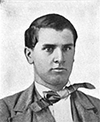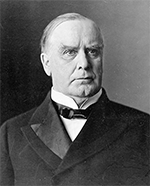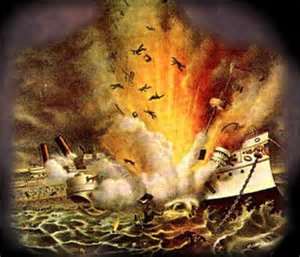William McKinley was a Civil War veteran, lawyer, and lawmaker who was the 25th President of the United States. 
He was born on Jan. 29, 1843, in Niles, Ohio. He was one of eight children of William and Nancy McKinley. Young William attended local public schools and then Poland Seminary. He left Allegheny College after a short time because of illness. He never finished his university studies but did serve as a schoolteacher for a time. He was also a postal worker. McKinley enlisted in the Union Army during the Civil War and began in the 23rd Ohio Infantry. Two of his commanders were William S. Rosencrans, a future Union general, and another future President, Rutherford B. Hayes. McKinley saw combat at the Battle of South Mountain, the Battle of Antietam, and then at the Battle of Buffington Island. He ended the war with the rank of major. Turning to the law, he studied privately with an Ohio lawyer and then attended Albany Law School, gaining admittance to the bar in 1867 and opening a law office in Canton. His experience including serving as a prosecuting attorney for Stark County and, on the other side of the bar, defending a group of coal miners who were arrested in the midst of a strike. He married Ida Saxton on Jan. 25, 1871. They had two daughters, neither of whom survived infancy. Turning to politics, McKinley won election to the U.S. House of Representatives in 1877, representing Ohio's 17th District. He was in the House until 1891, serving also in the 16th District, the 18th District, and the 20th District. He served on the influential Ways and Means Committee and became known as an expert on tariffs. His was the name attached to a well-known tariff bill in 1890. He won election to the governorship of his home state in 1892 and served until 1896 in that capacity. Gubernatorial terms were two years in those days, and he was re-elected once, in 1894. 
McKinley won the Republican Party nomination for President in 1896. The incumbent, Grover Cleveland, had presided over a full-blown depression that set in after the Panic of 1893 and was not chosen as the Democratic Party's standard-bearer. Filling that role was William Jennings Bryan, a former Nebraska Representative who was known for his superior oratory skills. His speech at the 1896 Democratic National Convention is one of the most famous in American history; in this "Cross of Gold" speech, he pleaded with the big business interests of America to reform the monetary system and end reliance on the gold standard. The election pitted Bryan, with his support made up of factory workers and farmers and small-business owners, against McKinley, with his support made up of banks, merchants, and factor owners. The election captivated the interest of most of the country, and the result was one of the highest turnouts by percentage in the country's history. When the dust had settled, McKinley had carried 23 of the 45 states. The states that McKinley carried provided the difference. His electoral vote tally was 271, to Bryan's 176. Once inaugurated, McKinley called Congress into a special session; the result was the Dingley Tariff, the highest protective tariff the U.S. had yet enacted. Foreign policy dominated McKinley's initial term in the Oval Office. Most prominent was the Spanish-American War. On February 15, 1898, the USS Maine exploded in Havana harbor, killing 266 American sailors. An initial U.S. Navy investigation concluded that the cause was an external source, presumably a mine in the harbor. Anger across America was great, and many people believed the story beginning to circulate that Spain was behind the explosion. New York newspaper publishers William Randolph Hearst and Joseph Pulitzer took the When war broke out, in April 1898, fighting took place in Cuban and in the Philippines. Spain had rejected a call from the U.S. Government to give up Cuba altogether; in response, Spain declared war. The American declaration of war followed soon after, and the struggle began. It ended up being a somewhat one-sided conflict in 1898 that resulted in Spain's giving up claims to Cuba, Philippines, Guam, and Puerto Rico and the U.S.'s taking possession of all but Cuba. Two years later, the U.S. was involved in another overseas conflict. Flowing on from the Open Door policy, announced by Secretary of State John Hay in 1899, the U.S. joined France, Germany, Japan, Russia, and the United Kingdom in stopping the Boxer Rebellion. Internally, McKinley was President when the U.S. annexed Hawaii, in 1898. Hawaii had given the U.S. permission to establish a naval base at Pearl Harbor in 1887. Further U.S. interests got involved in local politics and engineered an overthrow of the monarch, Queen Lili'uokalani. The Republic of Hawaii became the Territory of Hawaii, in 1900. Among the well-known legislation that McKinley signed into law was the Gold Standard Act, confirming his stance of favoring that precious metal during his initial election campaign. 
McKinley ran for re-election in 1900. His opponent was again Bryan. The economy was booming again, and voters much preferred to keep in office the leader who they credited for that success. The election results were much the same as the first contest between the two men, with McKinley handily winning both popular and electoral votes, the latter 292–155. McKinley's running mate had changed. His Vice-president, Garret Hobart, had died in 1899; for the election, the Republicans chose former New York Gov. Theodore Roosevelt, who was by then a very popular because of his war heroics in the Spanish-American War. McKinley finished less than one year of his second term as President. He had given a speech at the Pan-American Exhibit in Buffalo, N.Y., on Sept. 5, 1901. A crowd of 50,000 had attended the speech. The following day, an anarchist named Leon Czolgosz shot McKinley as he was greeting well-wishers. The President died eight days later, on September 14. |
|
Social Studies for Kids
copyright 2002–2025
David White



 opportunity to blame Spain for the explosion and did so in print, in huge, bold headlines. Historians of today look back on the articles written in the New York Journal (Hearst) and the New York World (Pulitzer) as propaganda, with many unproven allegations. At the time, however, those two papers were among the most influential in the country and the resulting swell of public opinion against Spain resulted in a movement toward support of war.
opportunity to blame Spain for the explosion and did so in print, in huge, bold headlines. Historians of today look back on the articles written in the New York Journal (Hearst) and the New York World (Pulitzer) as propaganda, with many unproven allegations. At the time, however, those two papers were among the most influential in the country and the resulting swell of public opinion against Spain resulted in a movement toward support of war.
